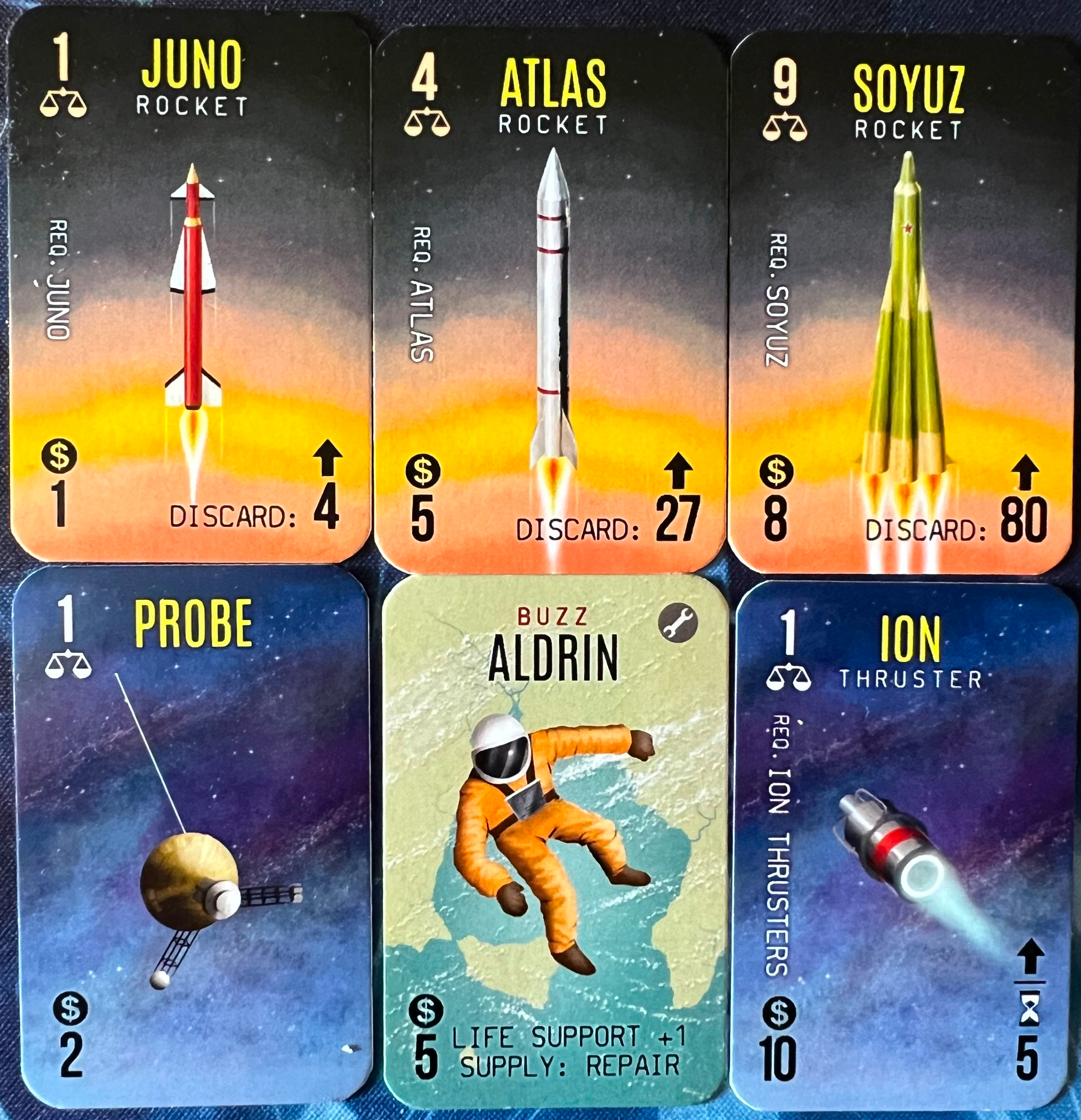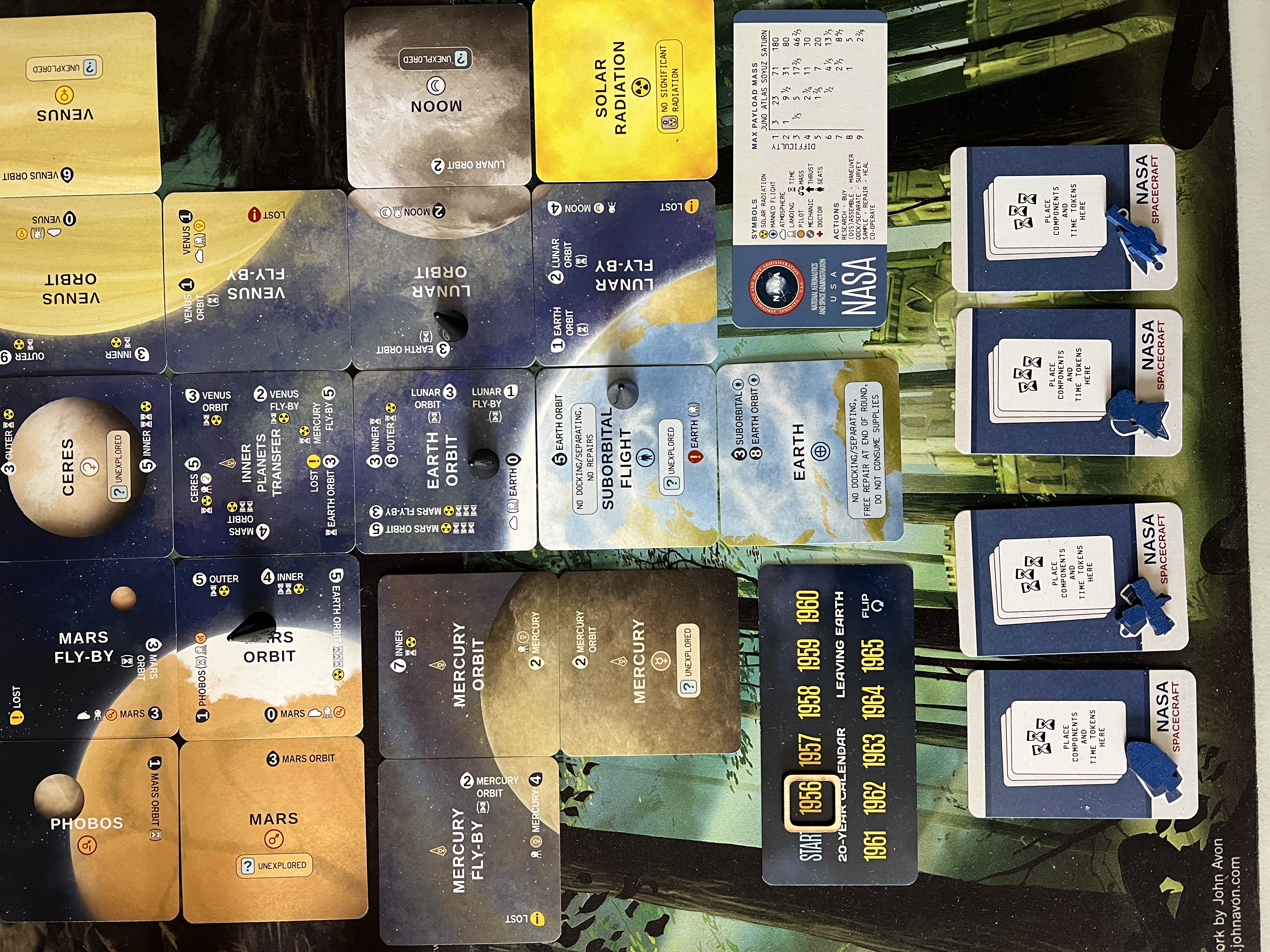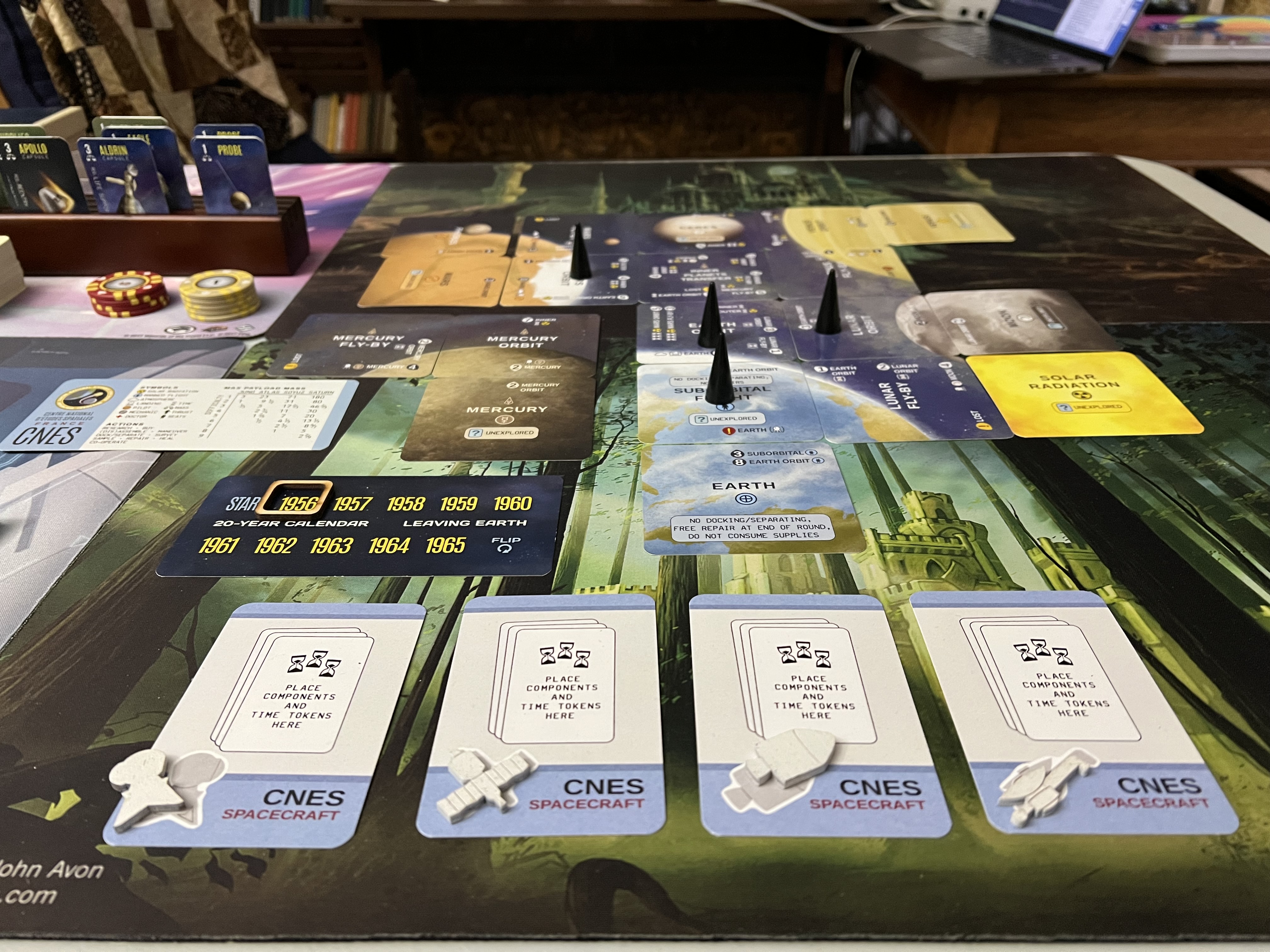Leaving Earth 12
Tags
(Game started March 10, 2025.)
I’ve been doing a bit of spreadsheet programming lately. Both in terms of creating programs within spreadsheets, and programmatically creating spreadsheets, specifically on Google Drive. I’m paying for a Workspace account so I might as well use it. In the past, I kept up with successive releases of Microsoft Office because everyone else was using it, but I never used it myself and got tired of the expense and update cycle. Sheets isn’t great, but it’s good enough for what I want to do.
Currently, I have a Ruby application (command line) which will create a sheet on my Google Drive account and pre-populate specified missions. This game is for helping determine what the next round of improvements will be. I haven’t played Leaving Earth in many years, so it’s going to take a couple of days of squeezing in the time to figure out the rules again.
The solitaire game of Leaving Earth is distinctly different than the competitive game, at least for me. In the competitive game, players must take many more risks to win compared to the solitaire game. In the solitaire game, winning is a matter of planning, nearly all of which can be done up front, after the missions are chosen, and before any advancement is purchases.
Planning in the solitaire game
Since there is no competitive pressure, the game orients itself to the time clock. There is a 20 year window to accomplish a victory, and every year and every mission can be scoped in advance.
Planning can be separated into three stages:
- Reverse calculation of mission needs from Earth Orbit;
- Launching components into Earth Orbit;
- Scheduling missions and advancements to minimize risk.
In a competitive game, risk has to be assessed with the actions of the competition rather than the state of advancements alone.
In the present game, Easy Mode, there are five Easy missions:
- Mars Survey
- Lunar Survey
- Man In Orbit
- Man in Space
- Sounding Rocket
In the solitaire game, these can be grouped into three, let’s call them “projects.” Each project consists of one or more more missions which can be accomplished all at once:
Project 1: Mars Survey. We need to get a Probe to Mars Orbit or Flyby, and have it be successful.
Project 2: Lunar Survey. We need get a Probe to Lunar Orbit or Flyby and have it be successful.
Project 3: Man in Orbit. Getting a man in orbit will satisfy the Man In Space and Sounding Rocket missions as well. It’s likely that Sounding Rocket will also be satisfied during Advancement testing.
Reverse planning, or, working backwards
The notion is to assume we have a successful mission completion state, and work backwards through the steps which produce that state.
For example, a Mars Survey requires getting a Probe to Mars, which will work correctly (not have a Major or Minor Failure) when the Survey is attempted. Assuming the Probe succeeds, we need to get the Probe to Mars, which requires composing a spacecraft consisting of the Probe and a successfully operating Thruster. In turn, we need to get one or more thrusters succesfully launched into Earth Orbit.
- Make a list of all the components I will need to purchase.
- Make a list of the necessary advancements I will need to purchase.
- Compute a few maneuvers without worrying about the spreadsheet for now.
(vim macro is @t)
Year 1956
-
Purchases: Atlas and Soyuz Advancements for $20, and 1 Atlas rocket.
-
Planning: Early game planning is all about purchsing and however much risk mitigation by way of testing makes sense in the context of the game. For an easy solitaire game, we’ll test everything to success, that is, remove all of the outcome cards.
That’s all the money spent for 1956.
Year 1957
- Purchases: 3 Soyuz and 1 Probe.
- Planning: We only lack the Surveying Advancement and we can start testing (and repurchasing) rockets. We don’t even need a Rendezvous as once the rocket stages have fire they are discarded.
Year 1958
For the Probe to work, we’ll need to Survey, which also requires an Advancement. Or, we could start testing. Let’s test Soyuz.
- Purchases:
- Planning: Test Soyuz twice, and if both successes then purchase an Atlas. If one or more failures, test to completion.
- Testing: Soyuz 1: Failure; Soyuz 2: Success; Soyuz 3: Success.
The Soyuz Advancement is complete!
Year 1959
Getting a Man In Orbit will require a Capsule of some sort, so we’ll need to add that to our list at some point.
- Planning: Let’s test all the Atlas rockets right now, and we’ll need to purchase another one for complete testing.
- Purchases:
- Testing: Atlas success.
- Action: purchase Atlas.
- Action: test Atlas, success.
Now we have one Outcome remaining on our Atlas Advancement.
BLUNDER I paid to remove the last Success Outcome, which was unnecessary. I could leave it on there as being the only remaining outcome, I would know what the result would be.
Year 1960
Planning Since Astronauts have 0 Mass (with respect to game play), we can choose the Apollo Capsule at Mass 1 to allow a single Soyuz to boost the Capsule into Orbit. The Apollo Capsule require the Landing Advancement, which we won’t actually need in this game.
Actions
- Purchase Surveying Advancement
- Purchase Atlas rocket
- Test Atlas rocket, success
We’re almost ready to start running the missions. In a competitve game, it makes sense to take more calculated risks.
Year 1961
Planning Let’s purchase a Soyuz and start testing Surveying from Earth Orbit. This let’s us be assured that our surveying won’t fail at Luna and Mars. Also, this is likely superfluous, as the Probe is not damaged when Surveying fails, a point I believe I have been playing incorrectly in the past. This would hold true for Capsules as well. Nevertheless, let’s do it anyway.
We’ll survey Solar Radiation.
Actions
- Puchase Soyuz.
- Launch Probe with Soyuz.
- Test Surveying, major failure.
- Test Surveying, success, Solar Radiation reveals “No Significant Radiation.”
- Test Surveying, success. I don’t need to pay for this one as it’s automatic. If it had been a Failure, I would have been stuck, as I only have $2 remaining, and would have to try again next turn. That’s low risk with Surveying, could be more expensive with rockets.
Score: 1 for Sounding Rocket.
Year 1962
Planning We can survey the moon no problem, and get set up for surverying Mars.
Actions
- Purchase Soyuz x 2, Atlas x 1, Probe x 2. This
- Launch Probe and Atlas to to Earth Orbit using both Soyuz as stages 1 & 2.
- Fire the Atlas to manuever to Lunar Flyby.
- Survey Luna, finding Valuable Minerals.
We still have a Probe in Earth Orbit, but it might be cheaper to boost a new one than to attempt the Rendezvous.
Score 1 + 4 for Lunar Survey.
Year 1963
Planning For the Man In Orbit, we have to bring him back down again. Let’s postpone that until the 3 year Mars mission is underway.
Actions
- Purchase Soyuz x 2, Atlas x 1, Eagle Capsule.
- Launch Probe and Atlas to to Earth Orbit using both Soyuz as stages 1 & 2.
- Fire the Atlas and Probe for Mars Flyby with 3 Time Tokens. Tokens are removed at the end of 1965, we can Survey Mars at the start of 1966 (we must, in fact, or the Probe will be lost).
Remove one Time Token from Mar mission.
Year 1964
Planning now it’s time to figure out how to get a man to orbit and back. We need to Test the Landing Advancement. Our options are to purchase a Juno Advancement and test with cheap rockets, or purchase Atlas rockets for more money, but save on the advancement cost. We’ll need to buy a couple of Soyuz rockets as well, so those can be purchases where it best conserves the spend.
Actions
- Purchase Landing Advancement, Soyuz, Atlas and Probe for $24.
Can’t do anything with the left over $1. In a competitive game, it might be worth buying gear or supplies for trading.
Remove Time Token 2 from Mars mission.
Year 1965
Planning what I should have done last year is started Tests for Landing. I’ll do that now.
Actions
- Launch Atlas with Probe to Suborbital, test landing.
- Purchase Soyuz, Atlas, Probe x 2.
Remove last Time Token from Mars mission, will survey at the beginning of the next year to get more victory points.
Inventory
Soyuz, Atlas, Probe x 2, Eagle.
1966
Planning The Landing Advancement still has 2 Outcomes on it, which need to be cleared, so that would be a good thing to do this turn. Also need to perform Mars Survey.
Actions
- Launch Atlas and Probe to Suborbital.
- Test Landing, pay $10 success.
-
Survey Mars, success finding Valuable Minerals. Score 5 points for 10 total.
This is technical a win for the game as I’ve now scored 10 of 14 points, that is, more than half. Let’s play it out and put a man in orbit and back.
- Purchase Atlas for $4.
- Launch Atlas, test Landing, success and no need to spend just discard it as it’s the last Outcome.
- Purchase Aldrin.
1967
Planning it looks like I can just launch and land Aldrin and I’ve got the Man In Orbit mission. All the Advancements are tested and I have all the components necessary.
Actions
- Launch Soyuz with Eagle and Aldrin to Earth Orbit.
- Land the Eagle capsule.
Note: Man in Orbit and back also gains Man In Space and back, the total is 6 points.
Score: 16.
Some pictures associated with this game
At the beginning of a game, I like to get a notion of which rockets and other components I will need to conduct missions. Here’s a picture of what I thought I would use, but it turns out I did not need the Ion rocket. What should be there is the Eagle Capsule.

The missions are marked with black cones. I will use yellow or orange cones next time as the black cones are too difficult to see on the image.

I initial started with CNES, and decided for some reason to change to NASA. I’m keeping the image below as I have a plan for working with the perspective.

AAR
Not a bad game. I ended up having to put it away to clear the table for a High Frontier game, but I was able to save the game state well enough to easily restart. The next game will be a Medium difficulty game, which will be after more Google Sheets updates.
On a side note, I’m really disappointed that Google doesn’t provided a publically supported API for better styling of individual cells. A real bummer and killed most of my motivation for automating with Google. Apparently they maintain a private API. I may have to dig into the actual API documentation though. This could be a limitation of the Ruby gem rather than the actual public API.
Updates for spreadsheet
-
Add a “Spacecraft Thrust” column between G and H. This will for computation without the need for creating some sort of custom Javascript.
-
Center the text in more if not all of the columns.
-
Add an Earth Orbit tab on all sheets. Everything needs to go there anyway, and the usual technique is get things into orbit and assemble them there. That said, it might be fun to try to do a one shot for a Lunar or Mars Survey.
-
Add Total Score column with the formula already provisioned on the Schedule sheet.
Also: check the actual API documentation to ensure GPT wasn’t lying to me about what is and is not supported via the Ruby gem.